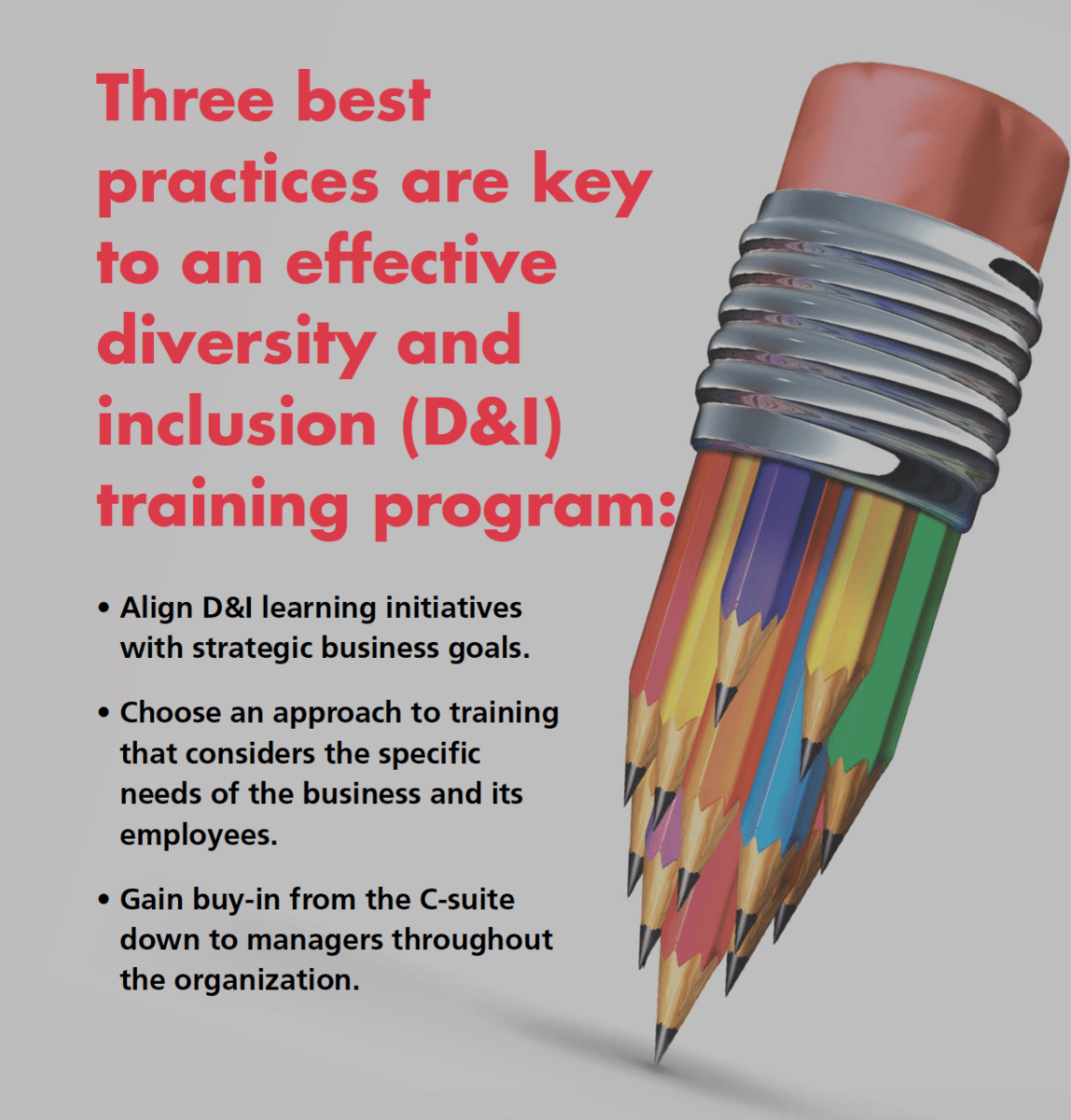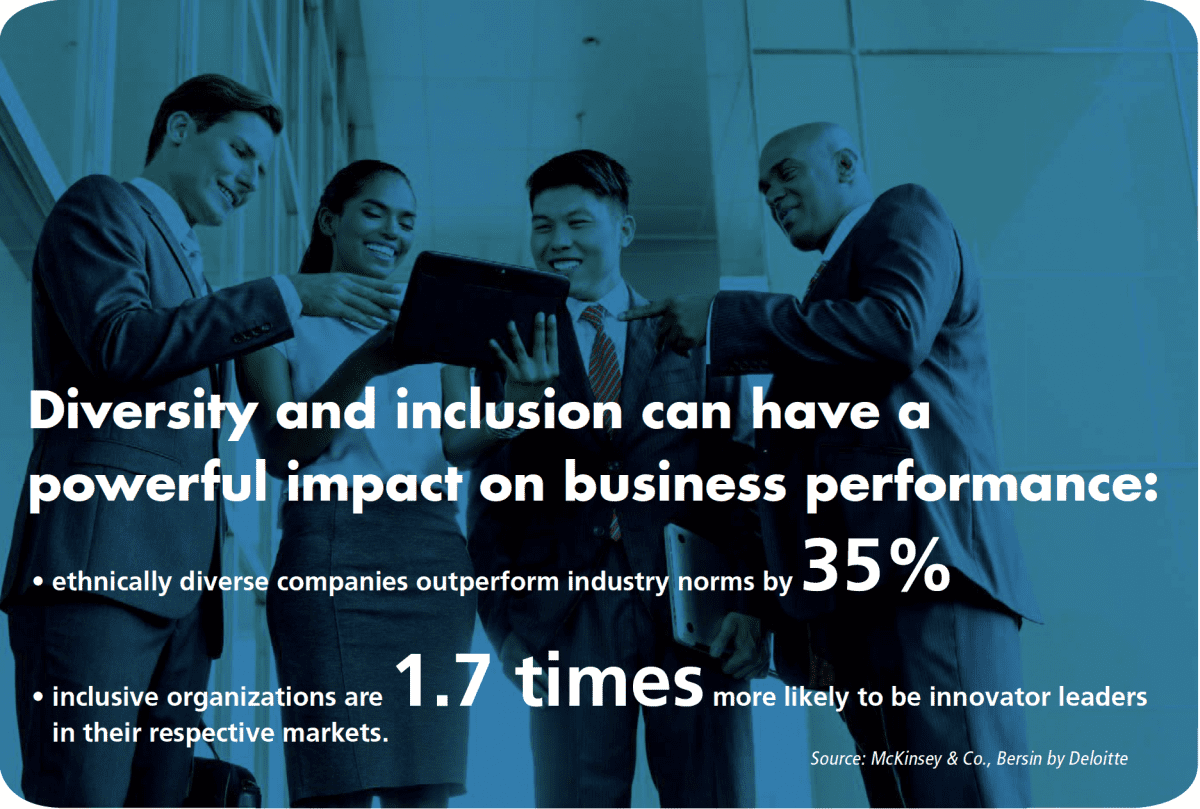Three important steps in implementing an effective diversity and inclusion training program that aligns with company needs.
By Aaron Lincove
In recent years, diversity and inclusion (D&I) have become top priorities for all businesses -and for good reason. Research by McKinsey & Co. reports that ethnically diverse companies outperform industry norms by 35 percent, and Bersin™, Deloitte Consulting LLP indicates that inclusive organizations are 1.7 times more likely to be innovator leaders in their respective markets. Given these benefits, it is no surprise that organizations of all sizes are realizing the value of D&I when it comes to employee engagement, financial performance, and brand recognition.
Diversity is more than a “feel good” initiative. Inclusion has a quantifiable impact on the bottom line. People care about how they are investing their time and resources, and company reputation can have a tremendous effect on their desire to purchase a product or accept a job offer. Not surprisingly, an organization’s stance on diversity and inclusion can influence the behavior of active and passive job seekers. According to the Boston Consulting Group, both men and women expect equality and inclusion in the workplace, and this expectation is even greater as the size of the millennial workforce increases. In fact, a survey by Randstad US claims that 78 percent of employees say a diverse workforce where people are treated equally is an important factor when evaluating organizations.
So, how can employers foster a culture of learning that encourages ideas from diverse backgrounds and aligns with the expectations of their current and future workforce? Companies need to approach D&I training with an innovative mindset, and these three best practices can help drive their success.
1. Align D&I training with strategic business priorities. D&I efforts cannot be driven by HR -they must be owned by the CEO through the executive team and then driven throughout the organization. All leaders must be willing and able to articulate why diversity and inclusion are important and how they tie back to organizational success from a cultural, financial, community, and brand perspective.
While D&I education must align with messaging, it is just as important that it reflects an organization’s core strategies. Education needs to support company goals like expanding complex services, building competitive scale, or differentiating from core competitors.
If this does not happen, D&I efforts are at risk of becoming a standalone endeavor. Rather than seeing these strategies as the responsibility of one person or department, D&I must be part of the company DNA and woven into how the organization serves its employees, customers, and shareholders. Whether it is hiring talent, developing new products, marketing, or engaging with customers, D&I must become part of everyday operations.
2. Match learning strategies to company culture. When developing D&I education programs, it is imperative that the form of learning matches the company culture and supports operations in a sensible way. For example, in the manufacturing industry, it is crucial that training does not pull employees off the floor for significant periods of time.
When determining what type of program works best, consider:
- What is the culture like?
- Is the culture one that drives program participation?
- Does the training program encourage collaboration?
- Will the desired learning strategy have an adverse impact on company operations?
- Will the training program drive the desired outcomes among this specific group of employees?
Learning events must educate employees in a highly impactful way, stimulate meaningful conversation, and allow people to have fun and make immediate behavioral changes. While traditional methods like PowerPoint training formats are easy, they are not always the most productive and can be highly disengaging.
Rather than talking at employees, D&I training needs to foster involvement. Gamification is a powerful option to get people active during training. Using learning maps, games, and technology prompts participants to think about problems and develop solutions in real-time, making the training more memorable and effective in a reduced amount of time.
3. Create a community of D&I champions. In addition to securing executive-level support, it is critical to have champions across the organization. Champions are midlevel employees who understand the importance and value of implementing D&I efforts or any new company-wide initiative. Champions become powerful advocates connecting the entire organization, as people are often more apt to listen to their peers versus leaders several levels above them.

D&I touches many aspects of the business, impacting recruiting efforts, customer perception, and financial success. In order to successfully educate employees, D&I training programs must align with the goals of the entire company, feature a learning strategy that fits the company culture, and secure executive buy-in. With strategic planning and mindful implementation, D&I education can positively influence organizations to make the right choices that will have lasting impact on their employees and the various communities they serve.
Aaron Lincove is the vice president and head of HR for Kenco Group.















